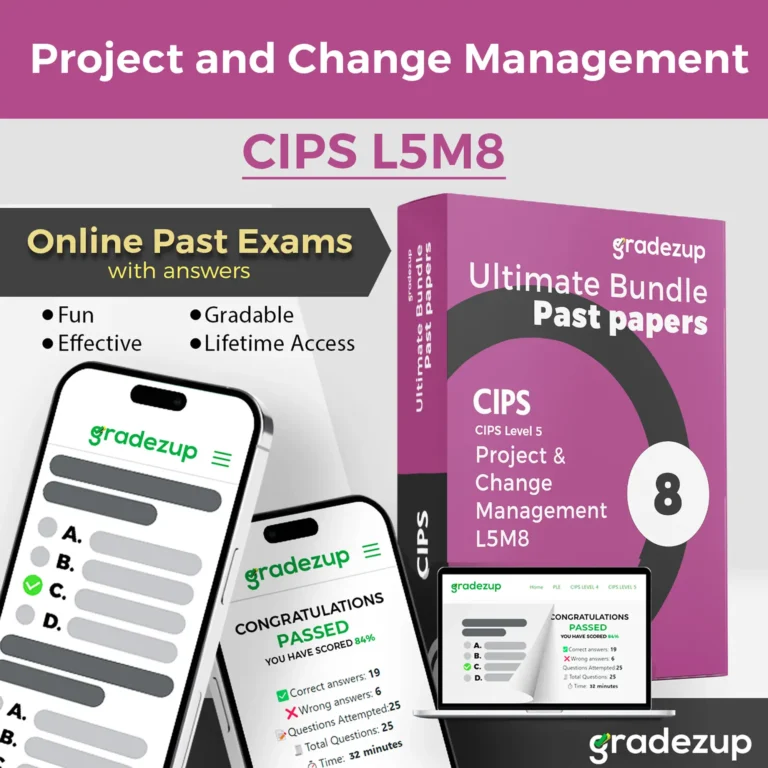
Ready to excel in your CIPS L5M8 Exams

Time's up
✨ Premium Access ✨
🔻 Access more CIPS L5M8 Exam Past Papers 🔻
Note: $4.99 grants you access to all papers (paper 1 – paper 10)
Gain access using
L5M8 Quick Exam-Ready Summary:
- Core Module
- Objective / Response Exam
- 1.5 hours Exam duration
- 60 Questions in exam
- 6 Credits Score
Principles of Project Management
Definitions, life cycle, WBS, CPM, Gantt, PRINCE2, PMBOK, success factors
Stakeholder & Team Management
Stakeholder analysis, Mendelow’s Matrix, team dynamics, conflict resolution, leadership
Change Management Principles
Lewin, Kotter, ADKAR, resistance to change, triggers for change, overcoming barriers
Risk, Governance & Control
Risk identification, risk tools, mitigation, governance bodies, RACI, stage-gates, BRM
Procurement’s Role in Projects/Change
Procurement strategies, contracts, supplier evaluation, role in transformation & improvement
CIPS L5M8 Exam Focus Areas – 2025 (Master List)
“These are core learning areas, but CIPS may include questions from other parts of the syllabus.” ⚠️
1. Principles of Project Management in Procurement and Supply
- Project Fundamentals:
- Definitions: project vs programme vs business-as-usual
- Characteristics of projects: unique, temporary, defined objectives, constrained resources
- Key success factors: scope, time, cost, quality, stakeholder satisfaction
- Project Life Cycle:
- Phases: initiation → planning → execution → monitoring & control → closure
- Procurement’s role at each stage (e.g., sourcing in planning, contract management in execution)
- Tools and Frameworks:
- Work Breakdown Structure (WBS)
- Critical Path Method (CPM), Gantt charts, milestone planning
- Earned Value Management (EVM) for cost/time control
- Project Management Body of Knowledge (PMBOK), PRINCE2 principles
2. Stakeholder and Team Management in Projects
- Stakeholder Analysis & Engagement:
- Mendelow’s Matrix (power vs interest)
- Communication planning, consultation, and reporting
- Building support and managing resistance
- Team Leadership and Dynamics:
- Tuckman’s model: forming, storming, norming, performing, adjourning
- Belbin team roles and cross-functional collaboration
- Conflict resolution techniques (win-win, compromise, collaboration)
- Change Leadership:
- Role of the project sponsor and project manager
- Leadership vs management in project settings
- Motivating and aligning teams to project objectives
3. Change Management Principles
- Nature of Change in Procurement:
- Triggers for change: technology adoption, supplier restructuring, process reengineering, sustainability targets
- Planned vs emergent change models
- Frameworks for Managing Change:
- Lewin’s Three-Step Model (unfreeze → change → refreeze)
- Kotter’s 8-Step Model for leading change
- ADKAR (Awareness, Desire, Knowledge, Ability, Reinforcement)
- Resistance to Change:
- Common causes: uncertainty, loss of control, cultural misalignment
- Techniques to overcome: communication, participation, training, incentives
4. Risk, Governance, and Control in Projects
- Project Risk Management:
- Identifying project risks (scope creep, delays, resource shortfalls, supplier failure)
- Tools: risk registers, probability-impact matrices, scenario planning
- Mitigation strategies (avoid, reduce, transfer, accept)
- Governance Structures:
- Role of steering committees and project boards
- RACI charts (Responsible, Accountable, Consulted, Informed)
- Escalation procedures and decision-making authority
- Control Mechanisms:
- KPIs and performance measurement
- Stage-gate reviews
- Benefits realisation management (BRM)
5. Procurement’s Role in Projects and Change
- Procurement Contribution to Projects:
- Sourcing strategies for project-specific needs
- Supplier selection and evaluation for project outcomes
- Contracting approaches for projects (fixed price, cost-plus, incentivised contracts)
- Managing supplier performance in project contexts
- Procurement and Organisational Change:
- How procurement drives organisational transformation (cost savings, innovation, ESG compliance)
- Procurement’s role in change initiatives (digitalisation, supply chain redesign, ethical sourcing)
- Embedding continuous improvement (Lean, Six Sigma, Kaizen)
View more CIPS Exams
Select the Exams you want to practice

